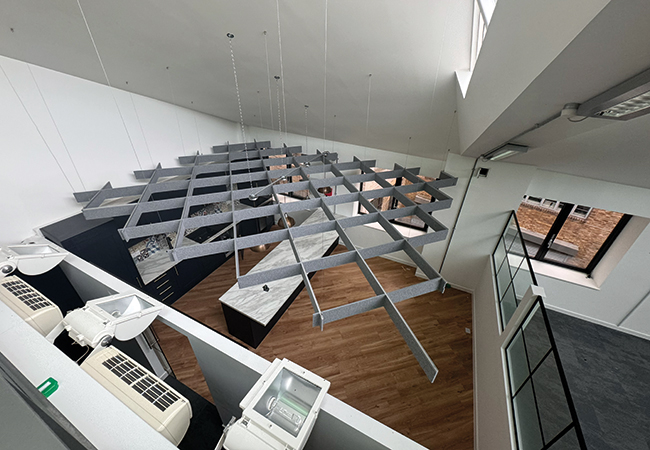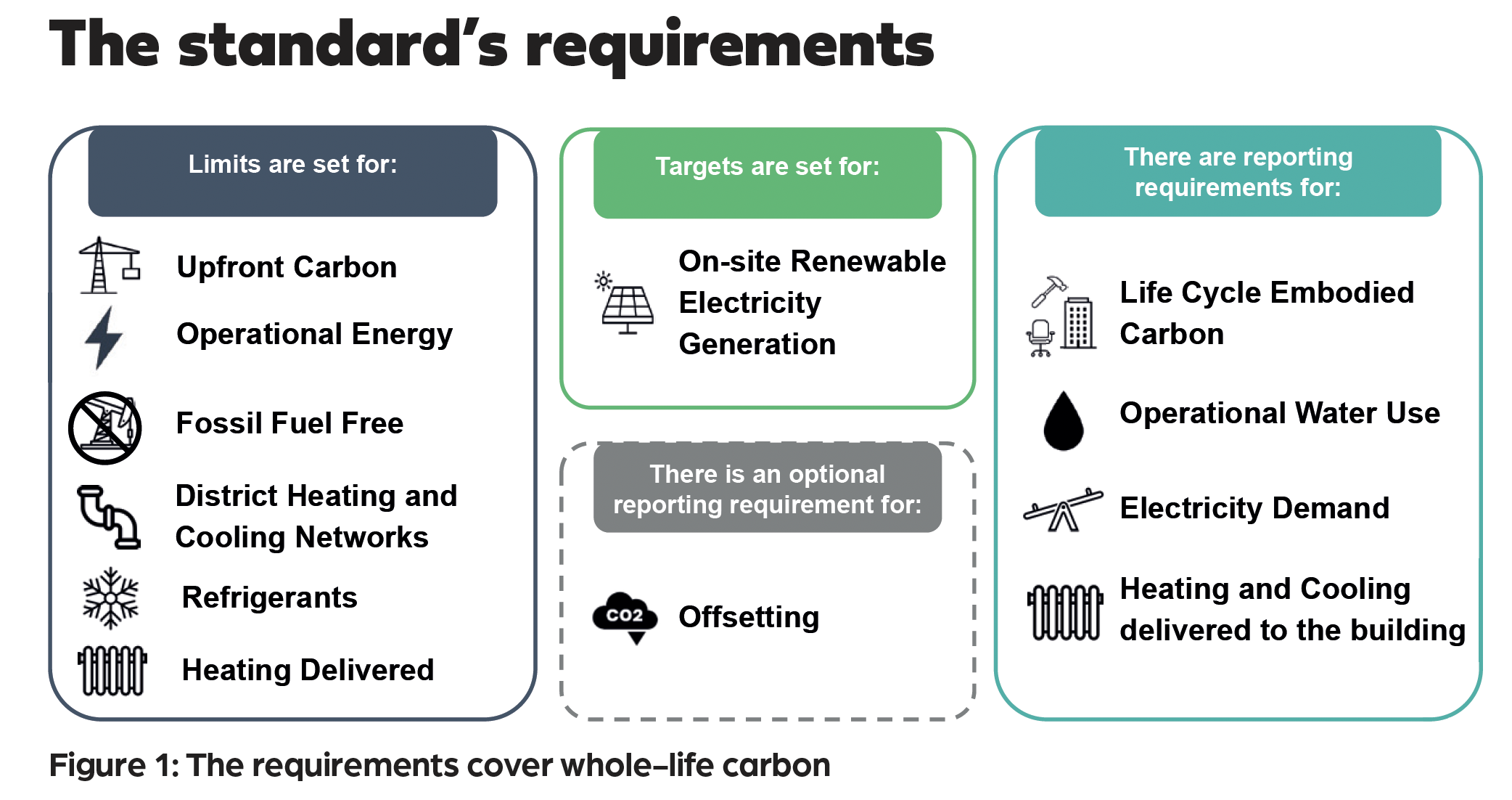
The NZCBS will be tested at CIBSE’S new head office in Saffron Hill
The UK Net Zero Carbon Buildings Standard (UK-NZCBS) Pilot was launched in September, after 2.5 years of effort from hundreds of volunteers, and widespread participation through calls for evidence, consultations and engagement workshops. The standard responds to demand from the market to limit greenwashing, ensuring clarity and providing a single reference on what it means for buildings to be ‘net zero’. It is a collaboration by leading organisations the Better Building Partnership, BRE, Carbon Trust, CIBSE, IStructE, LETI, RIBA, RICS, and UKGBC.
Top-down and bottom-up approach
The requirements of the NZCBS are science-led and aim to enable the UK built environment to stay aligned with its share of the national carbon and energy budgets, adhering to the 1.5°C trajectory. These requirements have been informed by what is needed to be achieved by the UK built environment – the ‘top down’ approach – and what is technically feasible now and in the future: the ‘bottom up’ approach.
To do this, a model of the UK building stock was created, expanding on the 2021 UKGBC roadmap. Scenarios from today to 2050 were applied to represent factors such as the performance of new and existing buildings, retrofit uptake levels, and future trends in embodied carbon – for example, materials decarbonisation, efficiency of materials use, and switching to lower-carbon materials. These scenarios were informed by the bottom-up analysis – that is, an assessment of the performance that can be achieved now and in the future. The outputs from these scenarios, in terms of embodied and operational carbon and energy use, were then measured against top-down carbon and electricity budgets, reflecting UK legal commitments to 2035 and 2050.
When defining budgets for embodied carbon, data from the Climate Change Committee was used, also taking into account extra-territorial embodied carbon emissions – that is, emissions abroad from products used in UK buildings. For electricity use and operational carbon, budgets are based on the National Grid ESO (now ESO) Electric Engagement scenario, assuming the Grid becomes near-zero carbon by 20351.
The standard is dynamic, and requirements will evolve over time to reflect technical developments
The NZCBS limits were then positioned within this UK built environment model, to represent ambitious, but achievable, levels of performance.
Independently from the NZCBS, this model is a highly valuable piece of work in itself, for identifying trajectories for a net zero UK built environment and to test the impact of trends and measures, such as materials decarbonisation, retrofit uptake, housebuilding targets, and so on.
What do the NZCBS requirements cover?

The standard has several requirements covering whole life carbon (see Figure 1). These will have to be demonstrated by actual performance – measured embodied carbon and metered energy use in occupation.
Requirements will evolve over time to reflect technical developments (for example, materials decarbonisation) and improvements in practices (for example, better operation of buildings).
For energy use, existing buildings can either meet the ‘end goal’ 2040 limit immediately or start with a less ambitious energy-use limit, accompanied by a compliant retrofit plan with gradual improvement to eventually meet the 2040 limit. The retrofit plan must comply with PAS 2035/8 and show that the step-by-step retrofit works meet the relevant upfront carbon limit. This is intended to encourage retrofit uptake and planning, and to support the development in skills and practices associated with the PAS, benefiting projects beyond the NZCBS.
NZCBS requirements and other schemes
The NZCBS has been informed by substantial analysis from 13 sector groups, considering the achievable performance of factors such as energy use, upfront carbon, refrigerant global warming potential, and onsite renewable electricity generation. This includes evidence from individual projects and large datasets, sectoral expertise, and a comparison with initiatives such as Passivhaus, Nabers, LETI, the RIBA Climate Challenge, the Scottish Futures Trust, and many others.
Where possible, the NZCBS has sought to align or provide a similar trajectory. For example, the ‘day 1’ NZCBS energy-use requirements for new-build homes are less ambitious than LETI and the Climate Challenge, but become more ambitious over time. From 2040, these will be aligned with LETI and the Climate Challenge, which is broadly equivalent to the performance of a Passivhaus home with a heat pump.
In other cases, the NZCBS differs because of its bottom-up analysis and industry feedback. For example, the NZCBS energy-use limit for new-build offices is less onerous than LETI and the Climate Challenge because of feedback that they were too onerous.
More information will be published on how the NZCBS requirements compare with other schemes, and with buildings whose performance has been used in the bottom-up analysis.
Future development
The pilot marks just the beginning, with several areas expected to evolve. Future developments will include new requirements informed by data, such as limits on life-cycle embodied carbon, and more specific guidelines that differentiate between landlord and tenant responsibilities, rather than focusing solely on whole-building performance.
The standard will recognise equivalence with existing schemes, allowing projects that meet comparable standards to satisfy NZCBS requirements, reducing the need for multiple verification processes. Metrics may also evolve to reflect energy use intensity.
Now is the time to get involved; access the pilot, provide feedback, and help shape the future of net zero buildings.
How to get involved
The pilot details all requirements of the standard, such as performance, reporting, and evidence requirements. Verification bodies and processes are now being put in place, for a full v1 release in late 2025. The pilot programme is expected to start Q1 2025, with registrations of interest open. The standard is available for free, alongside an overview document.
Anyone can, today, engage with the standard through resources available on its website, www.nzcbuildings.co.uk/pilotversion, where there is a feedback survey.
A launch webinar will take place on 31 October, and the recording will be available.
CIBSE is leading by example, testing the standard in its new offices at Saffron Hill, with results to be reported in the Journal. As the standard evolves with emerging data and technical advancements, it aims to be a cornerstone for ensuring the UK’s built environment aligns with national carbon goals –fostering a more sustainable future for all.
About the author
Julie Godefroy is a sustainability consultant and CIBSE head of net zero policy
References:
- Further analysis may be carried out to represent Grid decarbonisation by 2030, as targeted by the new government.
